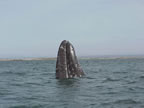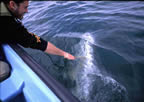home
| day one | two | three
| three-four | five | six
| seven-eight | nine | ten
| eleven | twelve | thirteen-fourteen
| fifteen
Day 3-4, Feb. 25-26, 2001
Laguna San Ignacio
Winter Home of Las Ballenas Gris (The Gray Whales)
We arrived at Laguna San Ignacio in the early afternoon, with no reservations and set to camp. We met Carlos Sextos, who runs Ecoturismo Kuyima. He told us we could have two cabanas, and we could go out with the whales that afternoon while they got them ready for us. We were thrilled, although it meant we wouldn't need the camping gear Jess went to the trouble of picking out. The cabanas are tiny but adorable, and provide a lot more shelter from the wind. They offer electricity until 10 p.m., compost outhouses, and sun showers. We were pleased with the hospitality we received, but nothing could prepare me for the encounters we were about to have with the whales.
We went out in a panga with our driver "Choppy" to see the whales. We had the panga to ourselves, and the weather was mild and sunny. It took about 15 minutes to get to the point where the whales congregate (and where Dad had camped before with Baja Discovery). We were seeing spouts everywhere. The large lagoon was clearly full of whales, and we headed straight into them. We didn't have to wait long for an encounter.
We came upon a curious whale almost immediately. Choppy slowed the motor, and waited to see if the huge gray whale would come to us. We watched as it submerged, and then appeared right next to our boat, just under the surface. The white barnacles and markings of its head began to show clearly just a few feet under the water, right next to the boat. Then we saw a huge burst of bubbles, and the whale surfaced within about three feet of our boat. We could almost touch him. The thrill sent my heart rate soaring. We scrambled around the boat to see him as he moved around us. It was incredible to be in a small boat and have such a huge creature surface right next to you.
We saw several whales on our first time out on the lagoon. We didn't end up touching one during our trip, but we had several come right up to the boat and surface, or swim right under our boat where we could see the massive size and length of these whales. We saw the whales spyhopping, breaching, doing something that looked like mating or playing, diving down to feed, and just lolling around on the surface.
When we got back to camp, we stopped for refreshments in one of the two main cabanas. These large huts, decorated with ocean themes, serve as dining rooms, meeting places, and the kitchen. Then we headed for our cabanas to get settled in. They sport two small cots with sleeping bags, some shelves, a few hand-painted accents and a spectacular view. Mine was named Pelicano. We watched a spectacular sunset, ate a dinner of fresh fish, mashed potatoes and veggies, and then made a Duraflame log fire on the beach. We talked, smoked cigars, and Dad and Jess drank El Presidente brandy. It was a fabulous way to cap the day.
On the second day, we went out twice in the pangas. The pangeros have different techniques, and some seem to be more in tune with the whales than others. Our morning driver appeared to scare away the whales. Even though we did see many of them, none stayed close for very long. In the afternoon, however, we encountered a mother and calf that seemed interested in us. Our driver let them come to us, and they stayed with us for quite a while. The baby whale was trying hard to get over its mother's massive back to play with us. Eventually they both swam directly under our boat, and surfaced several times near us. We knew they were interested in us, and the interaction touched us all. Our skiff driver also took us to see the mangroves across the lagoon. It was a sunny, beautiful morning and afternoon, and we enjoyed the break in our persistent storm, along with the fabulous scenery, including pelicans, herons, geese and other birds. The evenings and nights were downright cold, but whenever sun broke through the clouds we felt that hot Baja sun.
After a dinner of quesadillas, and ham for the carnivores, we watched a Howard Hall film in the main cabana. Then we made another fire, and took some timed exposure shots of us around the fire. We fired off the flash every minute or so on one of us. Dad practiced this technique before we left, and was very excited about taking these photos. We planned to leave early in the morning. It was hard to think about leaving, but we had other fish to fry, or something like that.
We met so many interesting and nice people at Laguna San Ignacio, people who came from all over the world to see the whales. Hilda and Tonio, both telecommunications engineers, came from Mexico City for their vacation. We met a couple from Spain, and a family from Mexico City. We particularly enjoyed talking to the kids, Rodrigo and Valeria, whose English and manners were impeccable. We met people from as far away as Austria, all coming to see the gray whales. The locals are pretty cool, too. We spent some time chatting with Teresa, Carlos' American wife. Teresa gave us an ink drawing she made of a whale as a goodbye present.
Teresa left her job as a school teacher to live in Baja with Carlos. They sing and play music together, make jewelry, and organize the whale watching operation. It seems an idyllic life. Coincidentally, they played music for about six months at the now-defunct Mangoes restaurant in San Luis Obispo at the same time I was a newspaper reporter there.
Life is full of coincidences. We also, incredibly, ran into Pepe Chagoyan on our second day at the lagoon. He was serving as tour guide to an Austrian couple. It is, indeed, a mundo pequeno (small world). Pepe worked on the Solmar V when Dad and I went to the Socorro Islands (Las Islas Revillagigedos.)
In Baja, life becomes surreal, and every day is magic. You can play with a whale, run into an old friend, see something you've never seen before, and make new friends in the time it takes to smile. Anything can happen here, it seems.



